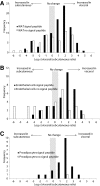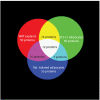Intrinsic depot-specific differences in the secretome of adipose tissue, preadipocytes, and adipose tissue-derived microvascular endothelial cells
- PMID: 20841607
- PMCID: PMC2992760
- DOI: 10.2337/db10-0483
Intrinsic depot-specific differences in the secretome of adipose tissue, preadipocytes, and adipose tissue-derived microvascular endothelial cells
Abstract
Objective: Visceral adipose tissue (VAT) is more closely linked to insulin resistance than subcutaneous adipose tissue (SAT). We conducted a quantitative analysis of the secretomes of VAT and SAT to identify differences in adipokine secretion that account for the adverse metabolic consequences of VAT.
Research design and methods: We used lectin affinity chromatography followed by comparison of isotope-labeled amino acid incorporation rates to quantitate relative differences in the secretomes of VAT and SAT explants. Because adipose tissue is composed of multiple cell types, which may contribute to depot-specific differences in secretion, we isolated preadipocytes and microvascular endothelial cells (MVECs) and compared their secretomes to those from whole adipose tissue.
Results: Although there were no discrete depot-specific differences in the secretomes from whole adipose tissue, preadipocytes, or MVECS, VAT exhibited an overall higher level of protein secretion than SAT. More proteins were secreted in twofold greater abundance from VAT explants compared with SAT explants (59% versus 21%), preadipocytes (68% versus 0%), and MVECs (62% versus 15%). The number of proteins in the whole adipose tissue secretome was greater than the sum of its cellular constituents. Finally, almost 50% of the adipose tissue secretome was composed of factors with a role in angiogenesis.
Conclusions: VAT has a higher secretory capacity than SAT, and this difference is an intrinsic feature of its cellular components. In view of the number of angiogenic factors in the adipose tissue secretome, we propose that VAT represents a more readily expandable tissue depot.
Figures




Similar articles
-
Exploring Visceral and Subcutaneous Adipose Tissue Secretomes in Human Obesity: Implications for Metabolic Disease.Endocrinology. 2022 Oct 11;163(11):bqac140. doi: 10.1210/endocr/bqac140. Endocrinology. 2022. PMID: 36036084 Free PMC article.
-
CILAIR-Based Secretome Analysis of Obese Visceral and Subcutaneous Adipose Tissues Reveals Distinctive ECM Remodeling and Inflammation Mediators.Sci Rep. 2015 Jul 22;5:12214. doi: 10.1038/srep12214. Sci Rep. 2015. PMID: 26198096 Free PMC article.
-
Cafeteria diet induces global and Slc27a3-specific hypomethylation in male Wistar rats.Adipocyte. 2021 Dec;10(1):108-118. doi: 10.1080/21623945.2021.1886697. Adipocyte. 2021. PMID: 33570456 Free PMC article.
-
Depot-specific hormonal characteristics of subcutaneous and visceral adipose tissue and their relation to the metabolic syndrome.Horm Metab Res. 2002 Nov-Dec;34(11-12):616-21. doi: 10.1055/s-2002-38256. Horm Metab Res. 2002. PMID: 12660870 Review.
-
Subcutaneous and visceral adipose tissue: structural and functional differences.Obes Rev. 2010 Jan;11(1):11-8. doi: 10.1111/j.1467-789X.2009.00623.x. Epub 2009 Jul 28. Obes Rev. 2010. PMID: 19656312 Review.
Cited by
-
BAFF knockout improves systemic inflammation via regulating adipose tissue distribution in high-fat diet-induced obesity.Exp Mol Med. 2015 Jan 16;47(1):e129. doi: 10.1038/emm.2014.98. Exp Mol Med. 2015. PMID: 25591987 Free PMC article.
-
Subcutaneous Adipose Tissue Transplantation in Diet-Induced Obese Mice Attenuates Metabolic Dysregulation While Removal Exacerbates It.Physiol Rep. 2013 Aug;1(2):e00015. doi: 10.1002/phy2.15. Physiol Rep. 2013. PMID: 23914298 Free PMC article.
-
Mechanisms of weight regain after weight loss - the role of adipose tissue.Nat Rev Endocrinol. 2019 May;15(5):274-287. doi: 10.1038/s41574-018-0148-4. Nat Rev Endocrinol. 2019. PMID: 30655624 Review.
-
NAFLD as a Sexual Dimorphic Disease: Role of Gender and Reproductive Status in the Development and Progression of Nonalcoholic Fatty Liver Disease and Inherent Cardiovascular Risk.Adv Ther. 2017 Jun;34(6):1291-1326. doi: 10.1007/s12325-017-0556-1. Epub 2017 May 19. Adv Ther. 2017. PMID: 28526997 Free PMC article. Review.
-
Developmental Programming: Impact of Gestational Steroid and Metabolic Milieus on Mediators of Insulin Sensitivity in Prenatal Testosterone-Treated Female Sheep.Endocrinology. 2017 Sep 1;158(9):2783-2798. doi: 10.1210/en.2017-00460. Endocrinology. 2017. PMID: 28911168 Free PMC article.
References
-
- Carey DG, Jenkins AB, Campbell LV, Freund J, Chisholm DJ: Abdominal fat and insulin resistance in normal and overweight women: Direct measurements reveal a strong relationship in subjects at both low and high risk of NIDDM. Diabetes 1996;45:633–638 - PubMed
-
- Björntorp P: Abdominal obesity and risk. Clin Exp Hypertens A 1990;12:783–794 - PubMed
-
- Kissebah AH, Vydelingum N, Murray R, Evans DJ, Hartz AJ, Kalkhoff RK, Adams PW: Relation of body fat distribution to metabolic complications of obesity. J Clin Endocrinol Metab 1982;54:254–260 - PubMed
-
- Vague J: The degree of masculine differentiation of obesities: a factor determining predisposition to diabetes, atherosclerosis, gout, and uric calculous disease. Am J Clin Nutr 1956;4:20–34 - PubMed
Publication types
MeSH terms
Substances
LinkOut - more resources
Full Text Sources
Research Materials

